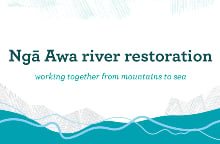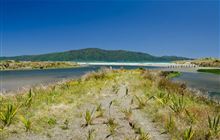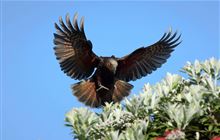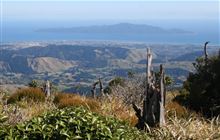Waikanae River restoration
Introduction
The Waikanae ki Uta ki Tai project is part of DOC's Ngā Awa river restoration programme.Waikanae ki Uta ki Tai
Waikanae ki Uta ki Tai is a mountains to sea project to restore values associated with the whole river catchment.
The vision is of waiora (healthy water) with community working together to enhance the lifeforce, vitality and special nature of the awa. Since the river is a living whole and the community is an intertwined part of it, by protecting and revitalising the river we will enhance our community identity, wellbeing and prosperity.
More information on proposals to revitalise the awa.
Project beginnings
Restoration work in the catchment has been carried out by community groups for many years – this is one of the reasons the river was selected as a Ngā Awa catchment. Waikanae ki Uta ki Tai was established in 2019. It fulfils a longstanding Waikanae community aim to coordinate the work of these groups and provide a mountains to sea approach to restoration.
Partnership provides direction and governance
Waikanae ki Uta ki Tai uses a Treaty house partnership model. Ātiawa ki Whakarongotai are the iwi house and DOC, Greater Wellington Regional Council and Kāpiti Coast District Council have aligned their roles as the kāwanatanga (government) house.
A project governance group has representatives from iwi and kāwanatanga project partners. It also provides governance for the Waikanae Jobs for Nature project. Both projects have a particular aim of helping Ātiawa ki Whakarongotai act as kaitiaki, as described in Whakarongotai o te moana Whakarongotai o te wa.
Vision, values and action plan
A project steering committee with iwi and community representatives has established a foundational vision, shared values, priority objectives and a list of potential actions. Te Pūtahitanga o te Wai, a project coordination group, is finalising and implementing the Waikanae ki Uta ki Tai action plan.
River health monitoring 2023
We studied the aquatic life, habitat and water quality at nine sites in the Waikanae River catchment between January and April 2023, with help from Waikanae Jobs for Nature kaimahi. The Cawthron Institute analysed the data and compiled the report below.
Review of river biodiversity 2022
A review of the existing information about the fisheries and biodiversity of the river was carried out in 2022. It included recommendations for restoration work and what further information should be gathered.
Jobs for Nature funding
In November 2020, Waikanae ki Uta ki Tai partners received $8.5 million of Jobs for Nature funding for river restoration. Over four years, Waikanae Jobs for Nature will boost funding for unemployed people in Waikanae and build on the kaupapa of Waikanae ki Uta ki Tai.
This new funding will enable employment for riverside fencing and planting, animal and weed control and sustainable land management, as well as community engagement, education and capacity building.
Values and demands on the river
The river provides drinking water for the Waikanae community. A river recharge scheme supplements water taken from it during times of peak demand and times of low water flows. The river is also highly valued for recreation, including walking and whitebait fishing.
Most of the catchment is in good condition, with clean water and diverse native fish species present, but these values decline in the lower reaches due to loss of fish habitat and river works.
The river is affected by demands from the communities in nearby urban areas. These include a wastewater treatment plant that discharges into the Mazengarb Stream and the Waikanae Estuary, along with stormwater. Works to help with flooding and erosion issues (gravel removal and stopbank management) have also been carried out in recent years.
Description of Waikanae River
The headwaters of Waikanae River are at Kapakapanui in the Tararua Forest Park, an area of native forest and alpine vegetation. The river travels west downstream for about 25 km before reaching the sea at the Kāpiti Coast.
In the mid-section, Waikanae River goes through areas of regenerating bush, plantation forest, small farms and lifestyle blocks. In its lower reaches there is significant urban development close to the river at Paraparaumu and Waikanae.
After passing though sand dunes and Waikanae Estuary Scientific Reserve, the river ends at Kapiti Marine Reserve. Beyond is Kapiti Island Nature Reserve, a pest-free sanctuary. Waikanae Estuary is a regionally significant area for bird habitat and fish spawning.
The river is a taonga (treasure) for mana whenua Ātiawa ki Whakarongotai, who have a kaitiakitanga (guardianship, management) plan setting out a set of kaupapa and huanga (values and objectives) for the river.
See a map of the Waikanae river catchment (PDF, 2,913K)
LEARNZ field trip resources
In July 2020, LEARNZ took a field trip to the Waikanae River and spoke to some of the people involved in the restoration work.
Contact
If you have any questions or want to get involved, email us.
Email: info@doc.govt.nz

About Ngā Awa river restoration
Ngā Awa is a programme working collaboratively in priority catchments to restore freshwater biodiversity.




